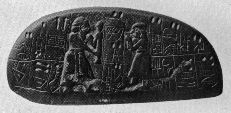iMahal Interview Series:
David Gimbel
July 22, 2001
iMahal:
You are obviously taking a unique path in your career! We like to delve into motivation in the people we interview. Our readers are curious about how successful people think. So, could you explain your interest in the Near-East? And why the interest in India?
 Gimbel:
I'm interested in studying the expansion of early cities, the development of writing and other systems of visual communication. I think that early visual forms of communication, which today we call art or advertising, were ways of organizing society. If you imagine Mesopotamia as a vast region without any stone in it, you could see why stone was a precious commodity. So carving a sculpture and transmitting programmatic messages through it is an important type of communication. You can think of writing as one form of communication. You can think of language as one form of communication. And you can speak of these visually-presented ideologies as a different type of communication. I was very interested in how humans evolved different structures that allowed them to communicate with each other in a more powerful way. I think those forms of communication are actually what caused group cohesion.
Gimbel:
I'm interested in studying the expansion of early cities, the development of writing and other systems of visual communication. I think that early visual forms of communication, which today we call art or advertising, were ways of organizing society. If you imagine Mesopotamia as a vast region without any stone in it, you could see why stone was a precious commodity. So carving a sculpture and transmitting programmatic messages through it is an important type of communication. You can think of writing as one form of communication. You can think of language as one form of communication. And you can speak of these visually-presented ideologies as a different type of communication. I was very interested in how humans evolved different structures that allowed them to communicate with each other in a more powerful way. I think those forms of communication are actually what caused group cohesion.
If you allow me to digress for a second, let me back down the timeline. An interesting statement was once made by Robin Dunbar who studied primates. He wrote a book called Grooming, Gossip, and the Evolution of Language.
|
..When you have enhanced communication you have enhanced group size and cohesion..
|
One of the primary points he makes in the book is that primates spend the majority of their time grooming each other, but in fact they don't require that much grooming. What is it that they do? His answer is that they are passing along social information: as group size increases, you need to be able to pass along more special information to enable group cohesion.
So I think that what social evolution is about, on a cognitive level, is increasing the types of communication that you can have. When you have enhanced communication you have enhanced group size and cohesion, which are beneficial to humans communities. You can't really have cities until you have writing, which allows you to do things like define, control, and record different types of labor and economic activity. You can define corvée labor, you can figure out who owes who what, you can figure out what taxes are due to the temple, and so forth.... In fact, the earliest writing is represented primarily by economic texts.

|
|
Sumerian
|
The majority of these texts do not appear to replicate or to imitate the sound patterns of language. There is little or no grammar or syntax implied in them, and it appears that the earliest stages of the Mesopotamian writing system could be read in either Sumerian or in Akkadian, languages from two entirely different families. One of the reasons that we can't really read these early texts in any meaningful way is that the graphemes, or signs, that are utilized by the writing system indicate information such as: two sheep, personal name 'X', city name 'X', and so forth.... The system is based on mnemonic content. You need a sense of what the text relates to in order to interpret it, because it doesn't have grammar, and it doesn't have syntax. It's not linguistic writing in the sense that we usually know it. So a lot of these early forms of writing actually came out of primitive iconic forms of representation. The earliest way to represent one sheep is to make a symbol that represents it. This can be a mimetic/iconic representation, or simply an abstract form such as a circle with an 'X' in it. The important thing is that there must be community consensus concerning symbol usage in order for these messages to be successfully recorded and transmitted. As one might expect, the majority of early signs rely upon mimetic forms of representation in which the sign for a fish, for example, looks something like the profile of a fish.
What happens is that, as writing evolves, you add more and more markers, many of which are abstract forms, in order to delimit aspects of linguistic behavior such as grammar and syntax. In Mesopotamia, writing became increasingly abstract in appearance as it evolved. I believe that this had to do with at least two things. It had to do, first of all, with the way it was written. They were using a stylus and were writing on clay. When they moved from etching, or drawing, images onto clay to using the stylus to imprint wedge-shaped indentations, the mechanics of the process took on a life of its own. It evolved to become more abstract until the markings no longer looked like the things they were originally supposed to represent. So what happened in Mesopotamia that didn't happen in Egypt, where the writing system remained iconic and phonetic, is that writing and other types of visual representations split off into two different streams.
Writing continued to be used for things like recording economic transactions. A different form of visual communication, which we call 'art' and which was eventually codified into a formal system containing rules for representation, such as register lines, frame boundaries, and hierarchical ordering of forms, evolved into a different system of communication. This system evolved to include visual narrative sequences, as well as more complex forms in which images interacted with textual displays; as such, it served a different set of purposes. First of all, these visual forms of display spoke to different audiences. Because ancient art relied primarily on iconic representation, it transmitted certain forms of information that practically anybody could understand, regardless of their linguistic identity. And because these images were often accompanied by text, there was a secondary level of information that was accessible to those who could read the text, which was heavily encoded.
In fact, writing for a long time was strongly encoded -- that is to say encrypted -- and there was a good reason for this. Writing was the operative structure that allowed people to organize societies, and if you want to maintain your control over that, you want writing that other people can't read. Of course what happened, over thousands of years, is that most forms of writing eventually evolved into -- or were eventually replaced by -- less complex systems, comprised of more easily understood symbolic forms that represented basic linguistic sounds.
|
..Writing was the operative structure that allowed people to organize societies..
|
Instead of having thousands of signs that represent different things we now have syllabaries and alphabets. One of the reasons that we evolved these simpler and more widespread writing systems is that, as societies grow, the value of increasing the clarity and efficiency of our communication systems eventually outweighs the value of universally encrypting systems for recording and transmitting information. Today almost everyone can read and write to some degree or another. It would be hard to imagine the evolution of large human social groups that include millions of members without the democratization of written forms of communication and message transmittal.
A much later change that illustrates how message transmission is important to social organization is the invention of the printing press, which provided new methods of dispersing information that added cohesion to society. You can also look at television, radio, and the Internet in that way. They are all related in a way: they each try to increase cohesion among larger and larger human group sizes. The ability to transmit and disseminate information is a powerful force, however, that can also be used to subversive ends. This is why totalitarian regimes always maintain strict control not only over the media, but over artistic production. Once you allow the wide dissemination of a written, spoken, or visual message, it is difficult to control its impact. Hence autocratic structures are very careful about the messages that they choose to transmit.
When we talk about the "world economy," the "global village," or whatever you want to call it, you can't even have that concept unless you have some way in which everybody in the world can theoretically communicate efficiently with everyone else. Interestingly enough, this concept came along at the same time as the arrival of the Internet.

|
|
Writing and Pictures
|
This is no surprise: communication is directly correlated to group size. So to get back to the original question, I became interested in Near-Eastern archeology because that's where these concepts first appeared, where humans first created writing and these highly-structured pictorial representations that allowed them to build huge communities, cities, and societies.
 iMahal:
Isn't it also possible that, because your ancestors came from Europe, which has its cultural origins in the Near-East, your path was chosen, in part, due to a personal affinity with what you perceived as your own cultural roots?
iMahal:
Isn't it also possible that, because your ancestors came from Europe, which has its cultural origins in the Near-East, your path was chosen, in part, due to a personal affinity with what you perceived as your own cultural roots?
 Gimbel:
I think that's absolutely correct. Perhaps it's embarrassing to admit, but I think all of us are on some kind of path to discover who we are about, and very often that lies along the lines of cultural affinity. So even though Sumerian society is deeply removed from us, nonetheless I see that as my roots. So I think you're right about that statement. That's probably one of the reasons it became a focal point of my interests.
Gimbel:
I think that's absolutely correct. Perhaps it's embarrassing to admit, but I think all of us are on some kind of path to discover who we are about, and very often that lies along the lines of cultural affinity. So even though Sumerian society is deeply removed from us, nonetheless I see that as my roots. So I think you're right about that statement. That's probably one of the reasons it became a focal point of my interests.

All photographs copyright and courtesy of David Gimbel or Archaeos





